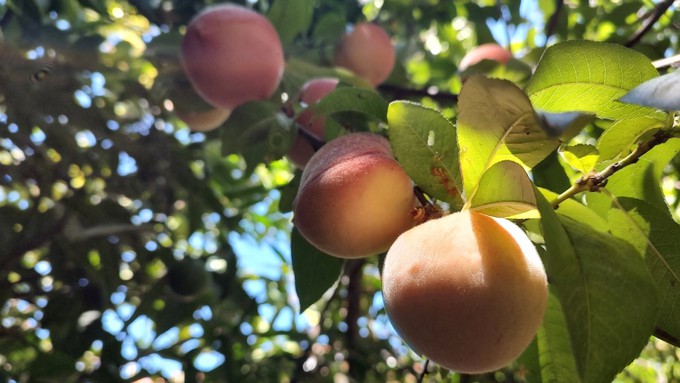
Yolo County master gardeners offer free workshop via Zoom

White peaches ripen on the tree within easy reach of picking. Summer pruning can help keep fruit trees compact and more productive. Debbie Arrington
Fruit trees can be perplexing for backyard gardeners – especially when (and how) to prune.
Here’s an opportunity to learn a lot without leaving home.
At 3 p.m. Thursday, May 23, the Yolo County Master Gardeners will host a Zoom presentation devoted to “Summer Fruit Tree Care and Pruning.” The free one-hour workshop is open to the public, no matter where they live.
“Did you know that there are benefits to pruning fruit trees in the summer?” ask the hosts. “Join experienced UCCE Master Gardener-Yolo Bonnie Berman for ‘Summer Fruit Tree Care and Pruning’ and learn the reasons for and the ‘how to’ of pruning in the summer.”
Pruning actually encourages growth. It’s also an opportunity to shape the tree, remove diseased wood and improve the health of the tree. Pruning at the right time can help set up a good harvest the following year.
For the Zoom link, contact Joan Tuss at Joan.Tuss@yolocounty.org.
Details: https://yolomg.ucanr.edu/.
Comments
0 comments have been posted.Sacramento Digs Gardening to your inbox.
Food in My Back Yard Series
April 29: What's (already) wrong with my tomato plants?
April 22: Should you stock up on fertilizer? (Yes!)
April 15: Grow culinary herbs in containers
April 8: When to plant summer vegetables
April 1: Don't be fooled by these garden myths
March 25: Fertilizer tips: How to 'feed' your vegetables for healthy growth
March 18: Time to give vegetable seedlings some more space
March 11: Ways to win the fight against weeds
March 4: Potatoes from the garden
Feb. 25: Plant a fruit tree now -- for later
Feb. 18: How to squeeze more food into less space
Feb. 11: When to plant? Consider staggering your transplants
Feb. 4: Starting in seed starting
Sites We Like
Garden Checklist for week of May 4
Enjoy this spring weather – and get gardening!
* Plant, plant, plant! It’s prime planting season in the Sacramento area. Time to set out those tomato transplants along with peppers and eggplants. Pinch off any flowers on new transplants to make them concentrate on establishing roots instead of setting premature fruit.
* Direct-seed melons, cucumbers, summer squash, corn, radishes, pumpkins and annual herbs such as basil.
* Harvest cabbage, lettuce, peas and green onions.
* In the flower garden, direct-seed sunflowers, cosmos, salvia, zinnias, marigolds, celosia and asters. (You also can transplant seedlings for many of the same flowers.)
* Plant dahlia tubers. Other perennials to set out include verbena, coreopsis, coneflower and astilbe.
* Transplant petunias, marigolds and perennial flowers such as astilbe, columbine, coneflowers, coreopsis, dahlias, rudbeckia and verbena.
* Keep an eye out for slugs, snails, earwigs and aphids that want to dine on tender new growth.
* Feed summer bloomers with a balanced fertilizer.
* For continued bloom, cut off spent flowers on roses as well as other flowering plants.
* Add mulch to the garden to maintain moisture. Mulch also cuts down on weeds. But don’t let it mound around the stems or trunks of trees or shrubs. Leave about a 6-inch to 1-foot circle to avoid crown rot or other problems.